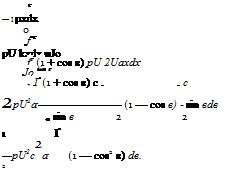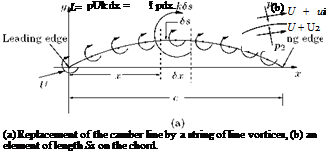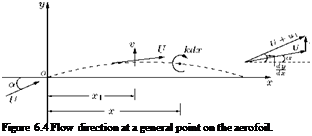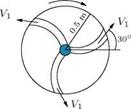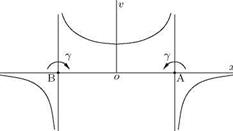Consider a continuous distribution of vortices on a straight line AB stretching from (—c/2, 0) to (c/2, 0), as shown in Figure 5.58.
Let the elements d§ of the line at point (§, 0) behave like a point rectilinear vortex of strength yd%, where у may be constant or a function of §. This element taken by itself will induce at the point P(x, 0) a velocity of dvx, in the negative y-direction, as shown in Figure 5.58, given by:
 Yd§
Yd§
§ – x
Thus the whole line of vortices will induce at P the velocity:

Note that in Equation (5.79), § is a variable and x is fixed. When § = x, the integrand is infinite. On the other hand, using the principle that a vortex induces no velocity at its own center, the point x must be omitted from the range of variation of §. To do this we define the “improper” integral Equation (5.79) by its “principal value,” namely:


In this way the point (x, 0) is always the center of the omitted portion between (x — є) and (x + e).
In the theory of aerofoil the type of integral (Equation 5.80) in which we shall be interested is that for which § =—Ic cos ф and y = Yn sin пф where Yn is independent of ф.
Now let x =—1 c cos в, where в, like x, is fixed. We get from Equation (5.79):
 sin пф sin фdф
sin пф sin фdф
0 cos в — cos ф
1 Ґ [cos (n — 1) ф — cos (n + 1) ф] dф
2^n J0 cos в — cos ф
In this relation, we have integral of the type:
 cos пф
cos пф
—Ъ——— т Лф.
cos в — cos ф
5.20 Summary
The following are the three possible ways in which a fluid element can move.
(a) Pure translation – the fluid elements are free to move anywhere in space but continue to keep their axes parallel to the reference axes fixed in space.
(b) Pure rotation – the fluid elements rotate about their own axes which remain fixed in space.
(c) The general motion in which translation and rotation are compounded.
A flow in which all the fluid elements behave as in item (a) above is called potential or irrotational flow. All other flows exhibit, to a greater or lesser extent, the spinning property of some of the constituent fluid elements, and are said to posses vorticity, which is the aerodynamic term for elemental spin. The flow is then termed rotational Bow.
The angular velocity is given by:
dv du 2o) = .
dx dy
The quantity 2o) is the elemental spin, also referred to as vorticity, Z. Thus:
The units of Z are radian per second. It is seen that:
that is, the vorticity is twice the angular velocity.
In the polar coordinates, the vorticity equation can be expressed as:
where r and в are the polar coordinates and qt and qn are the tangential and normal components of velocity, respectively.
Circulation is the line integral of a vector field around a closed plane curve in a flow field. By definition:
Circulation implies a component of rotation of flow in the system. This is not to say that there are circular streamlines, or the elements, of the fluid are actually moving around some closed loop although this is a possible flow system. Circulation in a flow means that the flow system could be resolved into an uniform irrotational portion and a circulating portion.
If circulation is present in a fluid motion, then vorticity must be present, even though it may be confined to a restricted space, as in the case of the circular cylinder with circulation, where the vorticity at the center of the cylinder may actually be excluded from the region of flow considered, namely that outside the cylinder.
The sum of the circulations of all the elemental areas in the circuit constitutes the circulation of the circuit as a whole:
Vorticity = lim ———————- .
area^0 area of element
A line vortex is a string of rotating particles. In a line vortex, a chain of fluid particles are spinning about their common axis and carrying around with them a swirl of fluid particles which flow around in circles.
Vortices can commonly be encountered in nature. The difference between a real (actual) vortex and theoretical vortex is that the real vortex has a core of fluid which rotates like a solid, although the associated swirl outside is the same as the flow outside the point vortex. The streamlines associated with a line vortex are circular, and therefore, the particle velocity at any point must be only tangential.
The stream function for a vortex is:
The potential function ф for a vortex is:
A vortex is a Bow system in which a finite area in a plane normal to the axis of a vortex contains vorticity. The axis of a vortex, in general, is a curve in space, and area S is a finite size. It is convenient to consider that the area S is made up of several elemental areas. In other words, a vortex consists of a bundle of elemental vortex lines or filaments. Such a bundle is termed a vortex tube, being a tube bounded by vortex filaments.
The four fundamental theorems governing vortex motion in an inviscid flow are called Helmholtz’s theorems.
Helmholtz’s first theorem states that:
“the circulation of a vortex tube is constant at all cross-sections along the tube."
The second theorem demonstrates that:
“the strength of a vortex tube (that is, the circulation) is constant along its length."
This is sometimes referred to as the equation of vortex continuity. It follows from the second theorem that Z S is constant along the vortex tube (or filament), so that if the cross-sectional area diminishes, the vorticity increases and vice versa. Since infinite vorticity is unacceptable, the cross-sectional area S cannot diminish to zero. In other words, a vortex cannot end in the fluid. In reality the vortex must form a closed loop, or originate (or terminate) in a discontinuity in the fluid such as a solid body or a surface of separation. In a different form it may be stated that a vortex tube cannot change its strength between two sections unless vortex filaments of equivalent strength join or leave the vortex tube.
The third theorem demonstrates that a vortex tube consists of the same particles of fluid, that is:
“there is no fluid interchange between the vortex tube and surrounding fluid."
The fourth theorem states that:
“the strength of a vortex remains constant in time."
By definition (Equation 5.3), we have the circulation as:
Г = ф V ■ ds.
The time rate of change of Г can be expressed as:
By Euler equation, we have:
Thompson’s vortex theorem or Kelvin’s circulation theorem states that:
“in a flow of inviscid and barotropic fluid, with conservative body forces, the circulation around a closed curve (material line) moving with the fluid remains constant with time, " if the motion is observed from a nonrotating frame.
The vortex theorem can be interpreted as follows:
“The position of a curve c in a flow field, at any instant of time, can be located by following the motion of all the fluid elements on the curve. "
That is, Kelvin s circulation theorem states that the circulation around the curve c at the two locations is the same. In other words:
where D/Dt(= d/dt + V ■) has been used to emphasize that the circulation is calculated around a material contour moving with the fluid.
With Kelvin’s theorem as the starting point, we can explain the famous Helmholtz’s vortex theorem, which allows a vivid interpretation of vortex motions which are of fundamental importance in aerodynamics.
The lift per unit span of an aerofoil can be expressed as:
where p and V, respectively, are the density and velocity of the freestream flow.
A closed line which surrounds only the vortex has a fixed circulation and must necessarily cross the discontinuity surface. Therefore, Kelvin’s circulation theorem does not hold for this line. A curve which surrounds the aerofoil only has the same circulation as the free vortex, but with opposite sign, and therefore the aerofoil experiences a lift. The circulation about the aerofoil with a vortex lying over the aerofoil, due to the boundary layer at the surface, is called the bound vortex.
The Stoke’s integral theorem states that:
“The line integral J u ■ dx about the closed curve c is equal to the surface integral JJ (y x u) ■ nds over any surface of arbitrary shape which has c as its boundary."
That is, the surface integral of a vector field u is equal to the line integral of u along the bounding curve:
where dx is an elemental length on c, and n is unit vector normal to any elemental area on ds. Helmholtz’s first vortex theorem states that:
“the circulation of a vortex tube is constant along the tube. "
A vortex tube is a tube made up of vortex lines which are tangential lines to the vorticity vector field, namely curl u (or f).
In an irrotational vortex (free vortex), the only vortex line in the flow field is the axis of the vortex. In a forced vortex (solid-body rotation), all lines perpendicular to the plane of Bow are vortex lines.
The integral:
(curlu) ■ nds
is called the vortex strength. It is identical to the circulation.
A very thin vortex tube is referred to as a vortex filament. The vortex filaments are of particular importance in aerodynamics. The angular velocity increases with decreasing cross-section of the vortex filament.
is an inhomogeneous Laplace equation, also called Poisson’s equation. The theory of this partial differential equation is the subject of potential theory which plays an important role in many branches of physics as in fluid mechanics.
Biot-Savart law relates the intensity of magnitude of magnetic field close to an electric current carrying conductor to the magnitude of the current. It is mathematically identical to the concept of relating
intensity of flow in the fluid close to a vorticity-carrying vortex tube to the strength of the vortex tube. It is a pure kinematic law, which was originally discovered through experiments in electrodynamics. The vortex filament corresponds there to a conducting wire, the vortex strength to the current, and the velocity field to the magnetic field. The aerodynamic terminology namely, “induced velocity” stems from the origin of this law.
The induced velocity is given by:
Г
v = —– (1 — cos в) .
4nr
The velocity induced at P by the element of length Ss is:
The induced velocity at a point P above vortex AB is:
where a = ZPAB and в = ZPBA.
A vortex is termed semi-infinite vortex when one of its ends stretches to infinity. The velocity induced by a semi-infinite vortex at a point P:
v =—— (cos a + 1) ,
4nh
where a = ZPAB and end B tends to infinity.
An infinite vortex is that with both ends stretching to infinity. For this case we have a = в = 0. Thus, the induced velocity due to an infinite vortex becomes:
_ Г 2nh
For a specific case of point P just opposite to one of the ends of the vortex, say A, we have a = n/2 and cos a = 0. Thus, the induced velocity at P becomes:
_ Г 4nh
The circulation of the vortex determines the lift, and the lift formula which gives the relation between circulation, Г, and lift per unit width, l, in inviscid potential flow is the Kutta-Joukowski theorem.
The Kutta-Joukowski theorem states that “the force per unit length acting on a right cylinder of any cross section whatsoever is equal to px УОТГОТ, and is perpendicular to the direction of VOT,” namely:
l = — рГи^,
where l is the lift per unit span of the wing, Г is circulation around the wing, is the freestream velocity and p is the density of the flow.
The lift of the whole wing span 2b is given by:
If a long time has passed since start-up, the starting vortex is at infinity (far downstream of the wing), and the bound vortex and the tip vortices together form a horseshoe vortex.
The velocity w induced at the middle of the wing by the two tip vortices accounts to double the velocity induced by a semi-infinite vortex filament at distance b. Therefore:
Г, ч Г
w = —— (1 + 0) = ——- .
4nb 4nb
This velocity is directed downwards and hence termed induced downwash.
The induced drag Di, given by:
w
Di = A—— .
‘ Uoo
The flow outside the vortex filament is a potential flow. Thus, by incompressible Bernoulli equation, we have:
The second vortex theorem of Helmholtz’s states that:
“a vortex tube is always made up of the same fluid particles."
In other words, a vortex tube is essentially a material tube. This characteristic of a vortex tube can be represented as a direct consequence of Kelvin’s circulation theorem.
The third vortex theorem of Helmholtz’s states that:
“the circulation of a vortex tube remains constant in time."
Using Helmholtz’s second theorem and Kelvin’s circulation theorem, the above statement can be interpreted as “a closed line generating the vortex tube is a material line whose circulation remains constant.” Helmholtz’s second and third theorems hold only for inviscid and barotropic fluids.
The fourth theorem states that:
“the strength of a vortex remains constant in time."
This is similar to the fact that the mass flow rate through a streamtube is invariant as the tube moves in the flow field. In other words, the circulation distribution gets adjusted with the area of the vortex tube. That is, the circulation per unit area (that is, vorticity) increases with decrease in the cross-sectional area of the vortex tube and vice versa.
Vortex is a fluid flow in which the streamlines are concentric circles. The vortex motions encountered in practice may in general be classified as free vortex or potential vortex and forced vortex or flywheel vortex.
Forced vortex is a rotational flow field in which the fluid rotates as a solid body with a constant angular velocity ю, and the streamlines form a set of concentric circles. Because the fluid in a forced vortex rotates like a rigid body, the forced vortex is also called flywheel vortex. The free surface of a forced vortex is in the form of a paraboloid.
Free vortex is an irrotational flow field in which the streamlines are concentric circles, but the variation of velocity with radius is such that there is no change of total energy per unit weight with radius, so that dH/dr = 0. Since the flow field is potential, the free vortex is also called potential vortex.
For a free vortex, the tangential velocity becomes:
This shows that in the flow around a vortex core the velocity is inversely proportional to the radius.
In a free vortex, pressure decreases and circumferential velocity increases as we move towards the center.
A free spiral vortex is essentially the combination of a free cylindrical vortex and a radial flow.
Flow in which the fluid flows radially inwards, or outwards from a center is called a radial flow.
A free spiral vortex is that in which a fluid element will follow a spiral path.
A rectilinear vortex is a vortex tube whose generators are perpendicular to the plane of motion.
A circular vortex is that with the shape of its cross-section normal to its axis of rotation as circular.
The existence of a vortex implies the co-existence of certain distribution of velocity field. This velocity field which co-exists with the vortex is known as the induced velocity field and the velocity at any point of it is called the induced velocity.
A circular vortex induces zero velocity at its center. Thus, a circular vortex alone in the otherwise undisturbed fluid will not tend to move.
Naturally occurring tropical cyclone, hurricane and typhoon which attains a diameter of from 150 to 800 kilometers, and travels at a speed seldom exceeding 25 kilometer per hour are circular vortices on a large scale. Within the area the wind can reach hurricane force, while there is a central region termed “the eye of the storm" of diameter about 15-30 kilometers where conditions may be completely calm.
Point rectilinear vortex is the limiting case of a circular vortex of constant strength у with radius a tending to zero.
Two vortices of equal strength у but opposite nature (one rotating clockwise and the other rotating counterclockwise) from a vortex pair.
![]() kbmax
kbmax![]() 0.0036
0.0036












